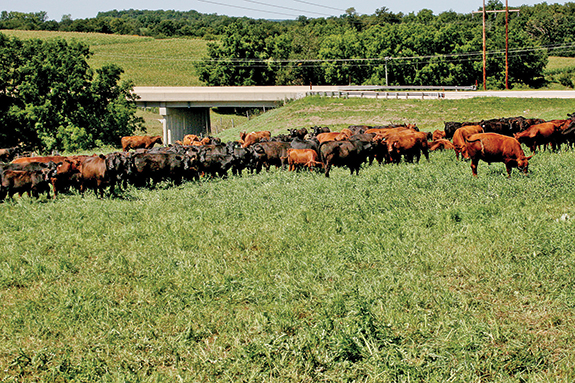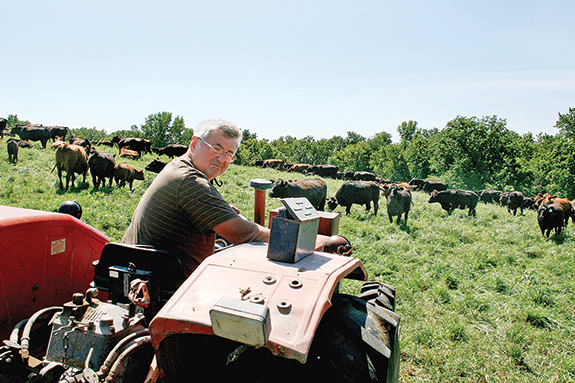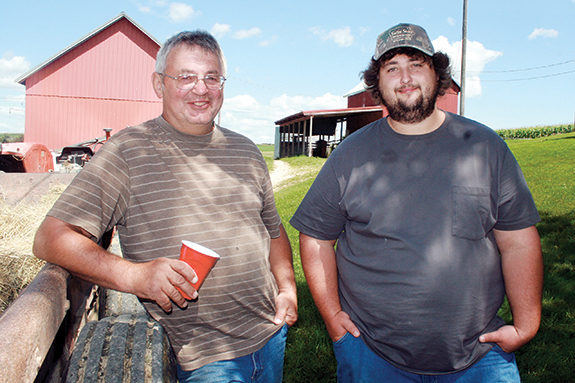Jason has been grazing beef cows on his northeast Iowa farm for more than 20 years, and Jordan has been working part-time on the farm since he was a child.
They farm 270 acres, most of which has been divided into 90 paddocks ranging from two to four acres. Most of the paddocks are fenced with poly-wire. They currently graze 90 cow-calf pairs and have about 80 yearlings.
Jason describes their pastures as “quite the mix.” The forage content varies from pasture to pasture and includes orchardgrass, fescue, brome, ryegrass and alfalfa with some red and white clovers, which establish voluntarily.
“I like having the diversity,” Jason says, noting that he avoids having too many of the grass types, such as fescue, which can choke out the plants. “I like the variety because the nutrients all even out in the end,” Jason says.
Klinges do not have a strict rotation that they adhere to for pasture management, but rather review the pastures as needed. If weeds are getting too thick, they may plant annual rye or corn to help to minimize the weeds.
They usually move their herd twice a day, and three times when necessary such as when the pasture is stressed due to lack of moisture.
One of the main things Jason says he bases his pasture decisions on is the need to control thistles. He says thistles and bare spots are the primary indicators that influence his decision to plow up a pasture or interseed it.
He hopes to do more interseeding this fall, especially around the watering sites where cattle tend to congregate in warmer weather, resulting in trampled plants.
He is also planning to do some additional interseeding in the spring to get some thicker stands, which will help choke out more weeds, keep the ground more shaded to help with moisture retention and increase tonnage per acre.
He works with a local seed dealer to make his final decisions of what to use when replanting or interseeding.
Jason says he does not fertilize pastures with anything except the manure the herd leaves behind, while the manure from the calving building goes onto the hay ground. Soil testing found the soil is not particularly lacking in nutrients that the pasture grasses need for forages.
The farm has been in the Klinge family for about 45 years. In decades past, when the soil was tilled and planted in crops, terraces were put in for soil conservation.
Jason and Jordan have been removing the terraces because they are not needed with the soil-retaining pasture plants, and the cattle don’t like moving around them.
When creating paddocks, Jason says he goes for the largest usable area containing a level watering site.
Jason says he really started to understand the potential for breeding for better grass-fed beef about ten years ago.
They had bought a few cows they felt were “ideal” and started saving bulls from those cows to use on the herd. This began to improve the genetics of their herd to breed better grazers.
They are purposely breeding their red and black Angus for grazing.
In the past decade, they have traveled to the West in search of cows that do well without grain, and they say they definitely have made headway.
The main traits they look for in breeding stock and bulls are small-framed animals that stay healthy and have hardy, deep bodies for good forage capacity, deep flanks and low birth weight.
Jordan explains, “When we look at EPD (expected progeny differences) scores on bulls, we look for a low birth weight for calving ease and an above-average weaning or yearling weight to still attain some growth on grass.
We also look at the ME (metabolized energy) score that pertains to how much feed the animal needs to function and the stayability score, which is how long the animal is expected to stay in the herd. Lastly, we look at marbling for meat quality.”
“The meat tastes better with marbling,” Jason says. “And we need cattle that can have good marbling without grain.”
They are currently fond of bulls descending from Beckton Julian B571. Julian is a Red Angus, a color the Klinges favor because the lighter cattle do better in the summer heat.
“The bulls from him are proven to do well on fescue and grasses and still keep their condition,” he says. Their first calves from these bulls hit the ground this spring, and he is anxious to watch them grow.
“We’ve definitely made progress,” Jason says. “The biggest changes we have seen have been in the increase of weight gain, and the calves have fewer health problems and are doing a lot better overall.”
Another very important trait Klinges work toward is longevity. “Most people don’t realize the costliness of a cow only having one or two calves before leaving the herd.”

Right now, due to heavy culling and bringing in new genetics, the Klinges’ herd averages about 4 years old, but they have quite a few cows that are 12 to 14 years old.
One of the management tools they use to see how well the cattle are doing on pasture forages is to weigh them every 30 days, especially while grass-finishing.
Jordan says they have been slowly increasing their herd size, buying everything from calves to heifers to bulls, but they have also been heavily culling to increase the overall quality of the herd.
They have also been using artificial insemination (A.I.) breeding to bring in good genetics. This spring about 10 of the calves were produced via A.I., and they plan on keeping the bulls from those calves as well.
“By the time they are mature, they are adapted to my grazing environment,” Jason says. “Calves that come from them should do well in this environment, too.”
How does Jason know a good cow from a bad cow? “I know it when I see it,” he says. He uses visual appraisal daily to monitor herd health, and is always watching for the overall genetic improvement of the herd.
Things he looks for include a moderate frame and sturdy deep-bodied animal for high feed consumption. He also watches out for good legs and frames and smooth coats.
In the winter months, the Klinges pasture graze as long as possible and feed dry hay, bagged silage and bagged small grains.
All of the land on the Klinge farm is certifiable organic, but the beef herd is not yet organic. They are still seeking products needed for herd management which are organic. FG
Kelli Kaderly-Boylen is a freelancer based in northeast Iowa.
PHOTOS
TOP: Jason and Jordan Klinge strive to make their pastures right for their beef herds, as well as improving herd genetics to produce better grazers.
MIDDLE: Herd longevity and marbling for meat quality also factor into the genetic decision matrix.
BOTTOM: Jason Klinge uses visual appraisal daily to monitor herd health, and watch for overall genetic herd improvement. Photos courtesy of Kelli Boylen.










